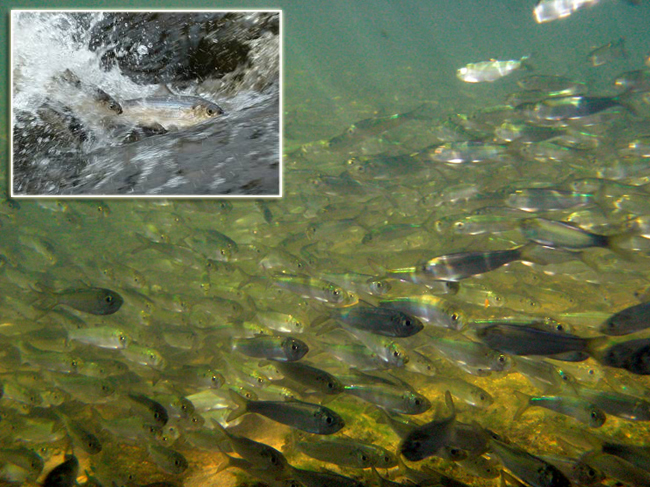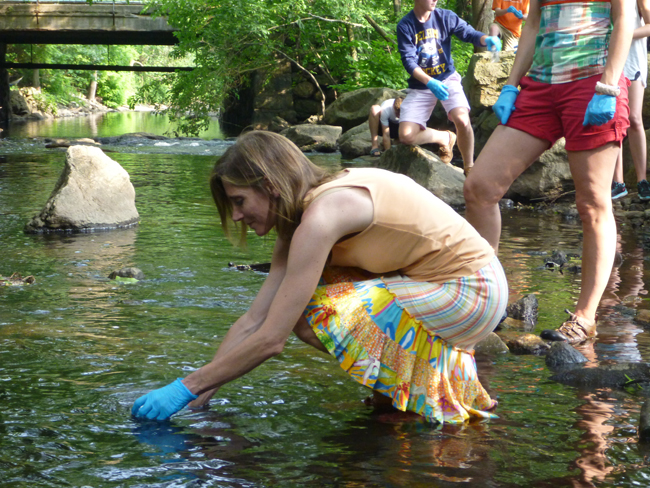|
|
Stewardship and You: Volunteer for Long Island Sound (February - September 2017)
By Paul F on Feb 26, 2017 at 5:54 PM

Alewives, a species of river herring native to Long Island, swim upstream in Connecticut. Like salmon, they split their life cycle between salt and freshwater. Credit: The National Oceanic and Atmospheric Administration
Working Together to Restore and Protect the Sound
There are many organizations in Connecticut and New York that need your help restoring and protecting Long Island Sound ...
Long Island Alewife Monitoring Workshops 2017
Long Island tributaries once supported spring runs of alewives returning from the ocean to spans. But dams, habitat loss and declining water quality have decimated their numbers. Remnant populations exist, but there is still little known about their overall status across Long Island. Documenting existing spawning runs is an important step in the restoration effort.
The 2017 Long Island Alewife Survey needs volunteers for returning alewives from March to May.
Learn about the river herring’s migration and take part in monitoring its spawning activity. All are welcome to attend and participate in this citizen science project. No experience required.
- Monday, February 27, 2017 at 4:30-5:30pm at the Cold Spring Harbor Whaling Museum, 301 Main Street, Cold Spring Harbor, NY 11724. Contact Victoria O’Neill at victoria.oneill@dec.ny.gov or 631-444-0441 to RSVP and for more information. Click here for the flyer.
- Thursday, March 2, 2017 at 5:30-6:30pm at the Manhasset Library, 30 Oderdonk Avenue, Manhasset, NY 11030. Contact Victoria O’Neill at victoria.oneill@dec.ny.gov or 631-444-0441 to RSVP and for more information. Click here for the flyer.
- Tuesday, March 7, 2017 at 7:30pm at the SPLASH Membership Meeting, Freeport, NY. Contact staff@seatuck.org to RSVP and for more information.
- Thursday, March 9, 2017 at 5:30-6:30pm at Cornell Cooperative Extension of Suffolk County’s 1st floor conference room, 423 Griffing Avenue, Riverhead, NY 11901. Contact peptalk@peconicestuary.org to RSVP and for more information.
- Thursday, March 23, 2017 at 6:30-7:30pm at Scully Estate, Islip, NY. Contact staff@seatuck.org to RSVP and for more information.
- The Long Island premiere of the DamNation documentary will be held on Tuesday, March 15, 2017 at 7:00pm at the YMCA Boulton Center, Bay Shore, NY. For more information on this event, click here.
Upcoming New York Volunteer Events
- Saturday, March 11, 2017 at 10:00am-12:00pm
Concrete Plant Park Clean up. Join United by Blue and the Bronx River Alliance for a cleanup of Concrete Plant Park, 1372 Westchester Avenue, Bronx, NY. United By Blue will provide all of the cleanup supplies. Pre-cleanup snacks will be available during check-in, courtesy of Cliff Bar. Please be sure to wear closed toe shoes and clothes that you don’t mind getting dirty or wet! Groups of all sizes are welcome! For more information and to register, click here.
- Saturday, March 18, 2017 at 9:00am-1:00pm
Alley Creek Salt Marsh Restoration. Help the NYC Parks Stewardship Team and the Natural Areas Conservancy restore a vital and dynamic urban resource—the salt marshes of Alley Creek, 228-06 Northern Blvd, Queens, NY! Volunteers will place logs made out of rolled coconut fiber, or coir logs, to shrink expanding tidal pools and restore historic salt marsh for habitat. The coir logs will create a temporary boundary to hold clean sand in place for new salt marsh plants. This work will help conserve the longevity of the Alley Creek salt marsh for birds, crabs, mussels, and other wildlife that rely on this vibrant ecosystem to live! Due to the physical nature of this project, volunteers must be 18 and older. Waders will be provided. Registration is required. Please register here.
Upcoming Connecticut Volunteer Events
- Friday, April 21, 2017 - Saturday, April 22, 2017 at 11:00am-6:00pm
Stratford Point Shoreline Restoration. Join Professor Mattei of Sacred Heart University to celebrate Earth Day at Stratford Point, Stratford, CT. The goal behind this event is to restore the natural habitats of the shoreline that have been degraded after years of abuse. Volunteers will help install 30,000 plants on the shoreline at Stratford Point. Volunteers are welcome to come and offer time over the course of the weekend to the project. For information on volunteering for the project, please contact Professor Mattei at matteij@sacredheart.edu. To register to volunteer, email Jo-Marie Kasinak at kasinakj@sacredheart.edu.
Save the Date: Upcoming Volunteer Events
Mark your calendars for these 2017 volunteer events:
Volunteer Spotlight
Article by Tracy Brown, the Director of Western Sound Programs at Save the Sound, as featured in Sound Update's Winter 2015-2016 issue:

Citizen scientists and Save the Sound staff work together to take water samples at beaches and in tributaries of Long Island Sound. Credit: Save the Sound
It’s hot out, but there’s no air conditioning in sight for Joann Rooney. As a volunteer citizen scientist, her morning routine doesn’t allow an escape from the heat. She’s out on the beaches of New Rochelle, working alongside Save the Sound staffer Peter Linderoth to take water samples. Peter tests the water for the bacteria Enterococcus as well as dissolved oxygen, pH, and other indicators of water quality.
Joann decided to volunteer with Save the Sound after decades of swimming and boating on the Sound. She’s seen what can happen when water quality isn’t up to snuff. While growing up swimming in the Sound, she rarely thought about its safety, but while training for a long-distance swim, she found she perpetually had a rash. Now she worries whether her grandson is safe swimming in the Sound.
And she’s right to be concerned. Skin irritation is a common effect of swimming in sewage-contaminated water, but less fortunate swimmers can develop pink eye, ear infections, diarrhea, or serious illnesses. That’s why local health departments often close beaches to swimming after rainstorms, and why Save the Sound tests to track down pollution hotspots.
Save the Sound expanded our water quality monitoring program from the Mamaroneck Harbor subwatershed in 2013 and 2014, to 52 sites in Westchester County and Greenwich this summer. We found that beaches tend to have the cleanest water, while streams are typically more polluted. Of the 52 sites monitored, only four passed EPA guidelines for safe swimming every time they were tested: Byram Beach, Greenwich Cove, and Indian Harbor Yacht Club in Greenwich, CT; and Mamaroneck Harbor at Taylor Lane in Mamaroneck, NY. Sixty percent of samples exceeded EPA safe swimming guidelines and over a quarter had Enterococcus levels greater than ten times the EPA standard. The highest bacteria levels were found in the Hutchinson River as it travels through Mount Vernon and Pelham, NY. We plan to continue building our model of testing combined with advocacy, which has proven valuable in identifying pollution problems and spurring action to fix them.
In addition to regular testing in Westchester and Greenwich, we’re looking at historical data from around the entire Sound. Our Sound Health Explorer, launched in July, is an interactive online map that shows state and local testing data from the last decade for every beach on Long Island Sound. It grades beaches based on their performance relative to others, to help swimmers choose the safest beaches to enjoy and to help municipal leaders spot potential problems in their towns. The project is open-source, so researchers can download the extensive data tables to use in their own work. Next, we plan to add information on dissolved oxygen and hypoxic conditions around the Sound. We encourage residents, scientists, and decision makers to check it out at www.SoundHealthExplorer.org.
If you would like to share your story of how someone is making a difference around the Sound, please contact Amy Mandelbaum, New York Sea Grant's Long Island Sound Study Outreach Coordinator, at 631-632-9216 or acb328@cornell.edu.
More Info: Long Island Sound Study
Long Island Sound is one of the 28 nationally-designated estuaries under
the National Estuary Program (NEP), which was established by Congress in 1987 to improve the
quality of Long Island Sound and other places where rivers meet the sea.
The Long Island Sound Study, conducted under the Environmental
Protection Agency’s (EPA) NEP, is a
cooperative effort between the EPA and the states of Connecticut and New
York to restore and protect the Sound and its ecosystems.
For more on what you can do to make a difference, click over to the "Get Involved" or "Stewardship" sections of the Long Island Sound Study's Web site. News on the Long Island Sound Study can also be found in New York Sea Grant's related archives.
If you would like to receive Long Island Sound Study's newsletter, please visit their site's homepage and sign up for the "e-news/print newsletter" under the "Stay Connected" box.
For daily updates and tips on how you can help protect and restore Long Island Sound, please join LISS on Facebook, Twitter or, sign up for their RSS feeds.
More Info: New York Sea Grant
New York Sea Grant (NYSG), a cooperative program of Cornell University
and the State University of New York, is one of 33 university-based
programs under the National Sea Grant College Program (NSGCP) of the
National Oceanic and Atmospheric Administration (NOAA). The NSGCP
engages this network of the nation’s top universities in conducting
scientific research, education, training and extension projects designed
to foster science-based decisions about the use and conservation of our
aquatic resources. Through its statewide network of integrated
services, NYSG has been promoting coastal vitality, environmental
sustainability, and citizen awareness about the State’s marine and Great
Lakes resources since 1971.
New York Sea Grant maintains Great Lakes offices at SUNY Buffalo, the
Wayne County Cooperative Extension office in Newark and at SUNY Oswego.
In the State's marine waters, NYSG has offices at Stony Brook University
and Stony Brook Manhattan, in the Hudson Valley through Cooperative
Extension in Kingston and at Brooklyn College.
For updates on Sea Grant activities: www.nyseagrant.org has RSS, Facebook, Twitter, and YouTube links. NYSG produces a monthly e-newsletter, " NOAA Sea Grant's Social Media Review," via its blog, www.nyseagrant.org/blog. Our program also offers a free e-list sign up via www.nyseagrant.org/coastlines for its flagship publication, NY Coastlines/Currents, which is published 1-2 times a year.
|